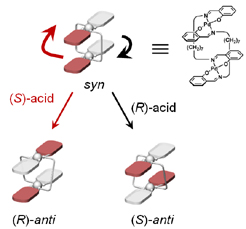- Home >
- Research »
- Contents
- Environmentally Benighn Organic Reactions
- Simulation of Flavoenzymes
- Au Nanoparticle Catalyst
- C-C Bond Formation of
Nitriles - Cyanocarbanions
- Functional Molecules
- Molecules that Illuminate by
Sound - Highly Phosphorescent
Crystals - Molecules that Assemble by
Sound - Crystals for Sick House Gas
- Molecular Rotation
Our group aims to create a novel class of highly functionalized organic molecules based on SYNTHETIC ORGANIC CHEMISTRY.
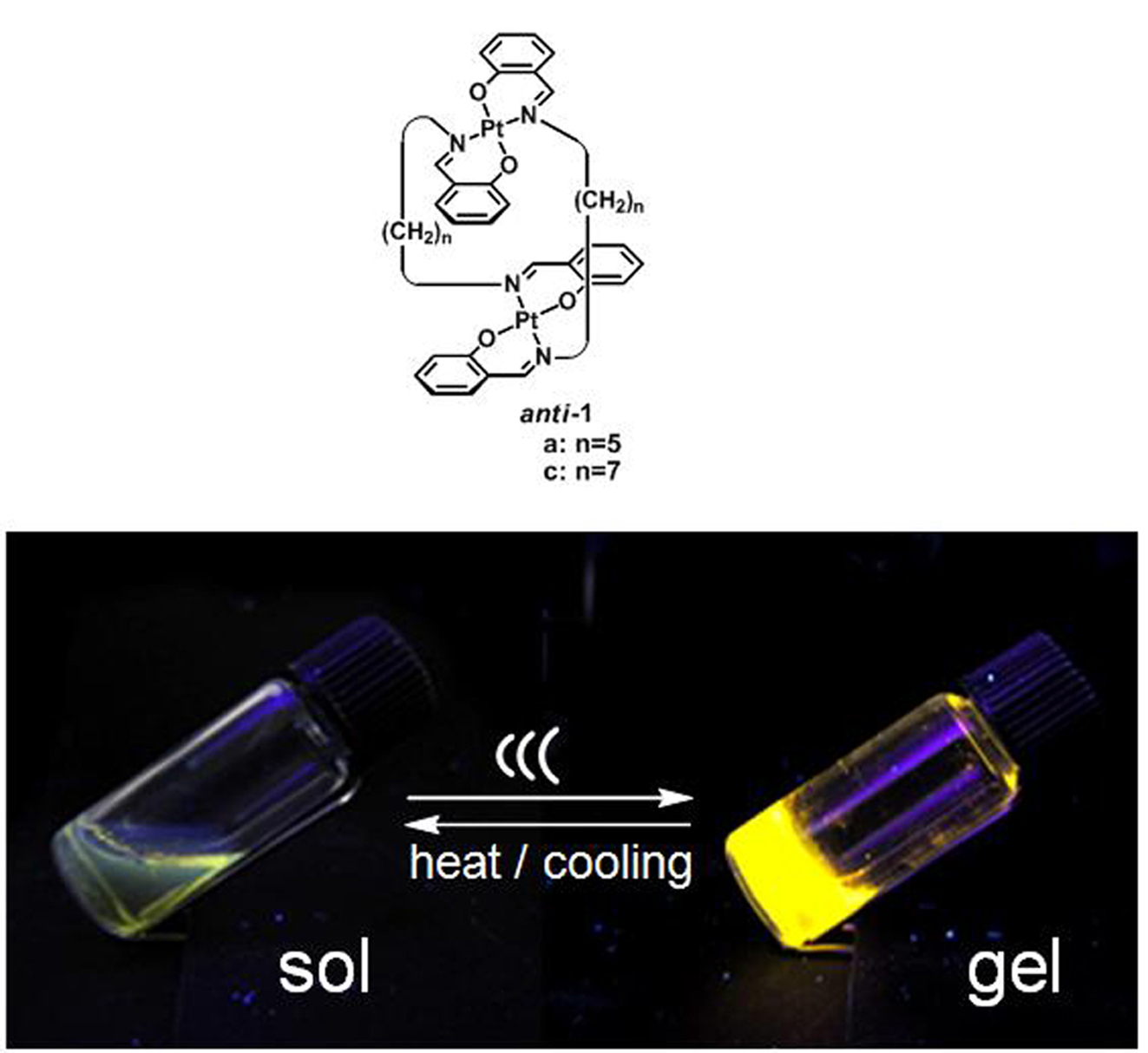
Molecules that Illuminate by Sound
In 2005, we have opened up a new chemistry of ultrasound-induced aggregations, where some specific molecules undergo instant aggregation upon brief irradiation of low powered ultrasound wave. As a consequence of the studies, we found that non-emissive solutions of clothes-peg shaped bimetallic Pt(II) complexes in organic liquids are transformed immediately into stable phosphorescent gels upon sonication. The long-lived, phosphorescent gels can be converted into the original non-emissive, long-lived solution states. This is a very new instant, remote and clear ON-OFF control of emission by non-chemical stimuli. The part of work was published in JACS (2011).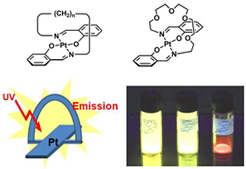
Highly Phosphorescent Crystals
We have succeeded in development of Pt complex crystals that exhibit high emission properties at room temperature upon irradiation of ultraviolet light. Although high-density integration is a straightforward concept to increase brightness of light-emitting materials, most materials that exhibit intense emission under low-density environments cannot maintain their emission efficiencies in the crystalline state due to inevitable energy loss by non-radiative pathways through intermolecular connection. This is a rare example of crystals showing intense phosphorescent emission with brilliant color of green, yellow, orange and red. XRD analyses revealed that the specific vaulted shape of the complexes act as molecular barrier to protect dispersion of photo-energy in crystalline state. Studies are now underway to create new organometallic phosphor crystals and to apply the principle to development of novel organic light emitting diodes. The major results were reported in JACS (2011), CEJ (2013), and CEJ (2013).
Environmentally benign organic reactions
Although organic synthesis is a fundamental key technology for prosperity of humankind, almost all methods for practical organic transformation are accompanied by the production of organic wastes, which badly affects the global environment and the lives of the people around the world. We are now eager to stop the consumption-intensive lifestyle to keep the earth clean. But, can you stop to use your own cancer drug in a future to keep the global environment? This is because the organic synthesis requires lots of energy and produce lots of chemical waste to make a small amount of cancer drug. The answer is definitively no. We cannot return back to the ancient age in order to save our earth. From this point of view, superficial recycling movement cannot be a final solution to this problem. We believe that one of primordial solution towards this dilemma is the creation of much more clean system for organic synthesis like as our body itself can do. We are doing such a research based on the simulation of enzymatic functions with organo- and organometallic catalysts, and succeeded in some typical environmentally benign process bearing high sustainability.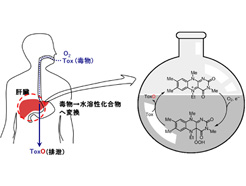
Simulation of hepatic enzymes with synthetic flavins as organocatalysts
Flavoenzymes are working in our liver as a ultimately clean chemical factory in our body. One of main functions of flavoenzymes is acting as a center of xenobiotic process, which detoxifies a lot of toxic compound coming inside in our body. After detoxification, the toxic compounds are changed to piece of water soluble compounds and discharged outside from our body as urine. We are simulating the principle of this ultimately clean chemical process by using a synthetic flavin, as a model organocatalyst of flavoenzymes. We succeeded in development of a variety of environmentally benign methods for oxidative transformations that can proceed under mild conditions of 1 atm of molecular oxygen or air. Our major results were reported in JACS (2005), ACIE (2005), and CEJ (2011).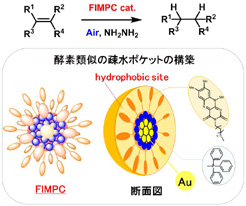
Flavin-linked Au nanoparticles for catalytic aerobic transformations
Puffball-shaped Au nanoparticles cross linked to flavin moiety were synthesized in order to create new enzyme-like oxidative transformations with high shape selectivity. We are seeking new type of the catalysts that exhibit enzyme-like catalytic activity only for the specific substrates. This motif is suitable for this purpose, since the controllable surface of the nanoparticle will provide a good cavity only for the special shaped molecules. We found this chemical puffball act as a highly specific catalytic activity for some oxidative transformation. This is one of second generation-catalysts aiming to enzyme-like specificity. Research is currently underway.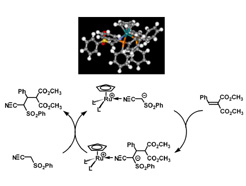
Carbon-carbon bond forming reactions of nitriles and the related carbanion chemistry
In 1989, we reported the first catalytic aldol and Michael reactions of activated nitriles. Nowadays, this original work and principle is widely used for the development of a variety of selective carbon-carbon bond forming reactions. Now we are investigating the reactivity of cyanocarbanions in view of inorganic and organometallic chemistry. Results were continuously reported in JACS (1989), JACS (1995), JACS (1998), JACS (2000), JACS (2002), and CEJ (2008).
Molecules that assemble by sound
When homogeneous, clear solutions of clothes-peg shaped bimetallic Pd complex, anti-1 in various solvents were irradiated with ultrasound for a few seconds, the stable solution state was completely converted to the gel state immediately after sonication. This new phenomenon and principle are drawing attention to many fields as a new tool for controlling sol-gel state, fluidity, viscoelasticity, optical transmission, and the related physical properties. You can solidify the gasoline immediately by this technique, which will be helpful to a variety of safety system.for bulk flammable liquids. Part of the original work was published in JACS (2005) and ACIE (2007), and the application to ultrasound-induced emission enhancement was reported in JACS (2011).
PINDI, the first organic crystals for sensing sick house gas
Sick house syndrome, occurs in your happy time just getting your new house, is very bad problem, because you can not specify why your health is getting worse and worse. Identification of a trace amount of volatile organic compounds such as toluene and formaldehyde is not so easy and it costs much money to specify the problem, because high spec machine is required for detection of these volatile compounds. PINDI, our new organic compound changes color from brilliant purple to yellow, when it absorbs formaldehyde molecules.When PINDI absorbs toluene vapor, it changed to orange. This will provide a cheap and convenient method for detection of such a toxic vapor. Synchrotron XRD analyses revealed that open-close motion of S-shaped folding unit of PINDI in crystal is a key for this unprecedented color change. Part of work was published in CEJ (2010).